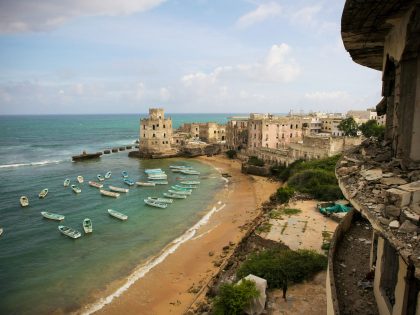The undeclared war in Somalia
The United States’ military operations in Somalia are not well known because they'e carried out secretly or via proxies. COVID-19 hasn't slowed them down.

Somali National Army soldiers. Public domain image credit Stuart Price for AU-UN Photo.
While the United States was waging what appeared to be a losing war against COVID-19 (the death toll is currently the highest in the world), its military was carrying out a high-tech battle against Al Shabaab thousands of miles away. On April 7th, the US Africa Command (AFRICOM) confirmed through a press release that Yusuf Jiis, described as “one of the foundational members of the terrorist group,” was killed in an air strike on April 2nd. The strike occurred in the vicinity of Bush Madina in Somalia’s Bay region, approximately 135 miles west of Mogadishu.
This was the second time that a “high value” Al Shabaab target was killed in a US air strike. In 2014, the influential Al Shabaab leader Ahmed Abdi Godane was also killed in an air strike. It was assumed that Godane’s death would weaken the group and reduce its capacity to carry out terrorist activities, but this did not happen. Terrorist attacks in Somalia—and in Kenya—continued and resulted in scores of deaths.
“Al Shabaab remains a disease in Somalia and is an indiscriminate killer of innocent people and their only desire is to brutalize populations inside Somalia and outside of Somalia,” said US Army Maj. Gen. William Gayler, AFRICOM’s director of operations, who was quoted in the press release. “Putting pressure on this network helps contain their ambition and desire to cause harm,” he continued.
AFRICOM commander, Gen. Stephen Townsend, stated, “While we might like to pause our operations because of the coronavirus, the leaders of Al Qaeda, Al Shabaab and ISIS have announced that they see the crisis as an opportunity to further their terrorist agenda, so we will continue to stand with and support our African partners.”
The April 2nd air strike was probably a response to the Al Shabaab attack on the US Manda Bay base in Lamu County in Kenya on January 5th this year. An American soldier and two US contractors were killed in that attack. The base, known as Camp Simba, is situated along the shores of the Indian Ocean, not far from the Somalia border. The Americans were killed when a rocket-propelled grenade hit a plane piloted by contractors from L3 Technologies, an American company hired by the Pentagon to carry out surveillance missions in Somalia.
It is unclear whether any Kenyans were killed in the attack, as the Kenyan government is notoriously secretive about Kenyan casualties, especially those involving the Kenya Defence Force (KDF). However, there were rumors that Kenyan soldiers hid behind bushes when the attack was taking place and did not make any attempt to fire at the terrorists, which left the US soldiers frustrated and dumbfounded.
There were no investigations by the local media on how the terrorist outfit managed to enter a secure US military installation and shoot at not just a plane, but also at a few stationary helicopters and even a fuel storage area. However, the New York Times did establish that injured Americans were flown to Djibouti (where AFRICOM has a base) for treatment. The New York Times further estimated that “the attack most likely cost the Pentagon millions of dollars in damages.”
The killing of Jiis was barely reported in the local or international press, but what is clear is that despite a looming health crisis at home, the US has not reduced its military operations abroad. According to the Foundation for Defense of Democracy’s Long War Journal, AFRICOM actually stepped up its air campaign against Al Shabaab in the first three months of this year, targeting the group 33 times in 2020 (more than half of 2019’s total). Samar al-Bulishi, a US-based expert on the “War on Terror” in East Africa, believes that “Al Shabaab’s actions [in Manda Bay] are a likely response to the United States’ rapidly expanding undeclared war in Somalia.”
Since the September 11th terrorist attacks in New York and Washington DC, the US has also employed drone technology and “surgical strikes” against suspected terrorists in Somalia, which became more common during President Barack Obama’s administration. AFRICOM, which began operations in 2007, and which is headquartered in Stuttgart, Germany, has been key in carrying out US military operations in Africa.
Many of these operations are not known because they are carried out via drones and not through direct combat. It is estimated that US drone attacks have killed between 900 and 1,000 Somalis in the past three years alone and that the Pentagon carried out 63 drone attacks in Somalia last year. Amnesty International has been documenting these drone attacks and claims that many of the casualties are, in fact, civilians, not terrorists. This has raised questions about whether such attacks are counterproductive in that they generate fear and loathing of the US government among the general civilian population.




